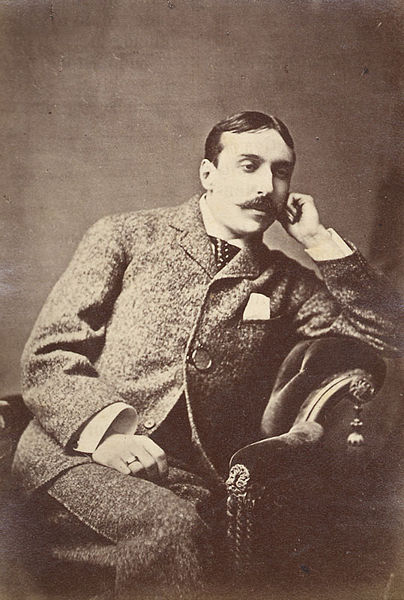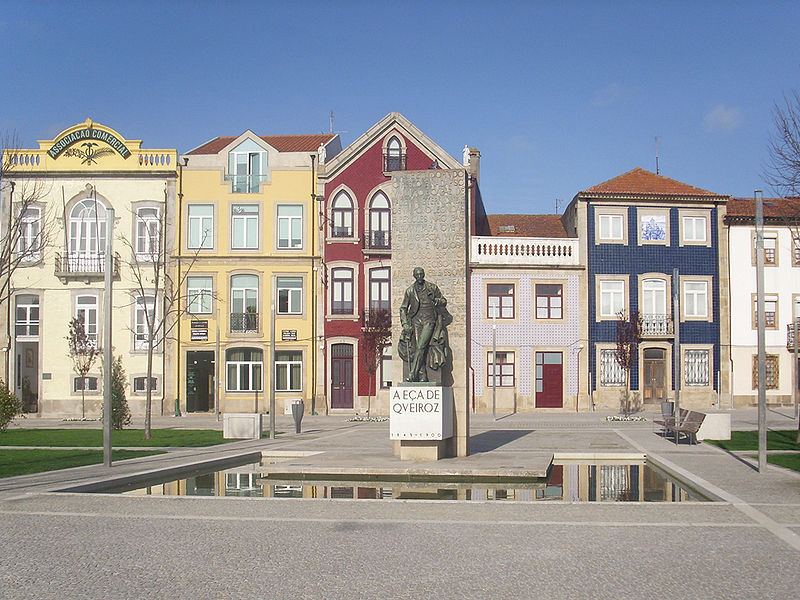<Back to Index>
- Physicist Julius Robert von Mayer, 1814
- Writer José Maria de Eça de Queiroz, 1845
- Chairman of the Presidium of the Supreme Soviet Anastas Ivanovich Mikoyan, 1895
PAGE SPONSOR


José Maria de Eça de Queiroz or Eça de Queirós (November 25, 1845 – August 16, 1900) is generally considered to be the greatest Portuguese writer in the realist style. Zola considered him to be far greater than Flaubert. The London Observer critics rank him with Dickens, Balzac and Tolstoy. Eça never officially rejected Catholicism, but was very critical of the Catholic Church of his time, and of Christianity in general (also Protestant churches) as is evident in some of his novels.
He
used the old-fashioned spelling "Eça de Queiroz" and this is the
form that appears on many editions of his works; the modern standard Portuguese spelling is "Eça de Queirós". Eça de Queiroz was born in Póvoa de Varzim, Portugal,
in 1845. An illegitimate child, he was officially recorded as the son
of José Maria de Almeida Teixeira de Queiroz, a Brazilian judge,
and of an unknown mother. Teixeira de Queiroz soon afterwards married
Carolina Augusta Pereira d'Eça, and it has been suggested that
in reality the boy was her son by an unknown father, or even that he
was instead both his and her son, as most genealogists and relatives
contend. At age 16, he went to Coimbra to study law at the University of Coimbra; there he met the poet Antero de Quental. Eça's first work was a series of prose poems, published in the Gazeta de Portugal magazine, which eventually appeared in book form in a posthumous collection edited by Batalha Reis entitled Prosas Bárbaras ("Barbarous texts"). He worked as a journalist at Évora, then returned to Lisbon and, with his former school friend Ramalho Ortigão and others, created the Correspondence of the fictional adventurer Fradique Mendes. This amusing work was first published in 1900. In 1869 and 1870, Eça de Queiroz travelled to Egypt and watched the opening of the Suez Canal, which inspired several of his works, most notably O Mistério da Estrada de Sintra ("The
Mystery of the Sintra Road", 1870), written in collaboration with
Ramalho Ortigão, in which Fradique Mendes appears. A Relíquia ("The Relic") was also written at this period but was published only in 1887. When he was later dispatched to Leiria to work as a municipal administrator, Eça de Queiroz wrote his first realist novel, O Crime do Padre Amaro ("The Sin of Father Amaro"), which is set in the city and first appeared in 1875. Eça
then worked in the Portuguese consular service and after two years'
service at Havana was stationed at 53 Grey Street, Newcastle upon Tyne,
from late 1874 until April 1879. His diplomatic duties involved the
dispatch of detailed reports to the Portuguese foreign office
concerning the unrest in the Northumberland and Durham coalfields
- in which, as he points out, the miners earned twice as much as those
in South Wales, along with free housing and a weekly supply of coal.
The Newcastle years were among the most productive of his literary
career. He published the second version of O Crime de Padre Amaro in 1876 and another celebrated novel, O Primo Basílio ("Cousin
Basílio") in 1878, as well as working on a number of other
projects. These included the first of his "Cartas de Londres" ("Letters
from London") which were printed in the Lisbon daily newspaper Diário de Notícias and afterwards appeared in book form as Cartas de Inglaterra. As early as 1878 he had at least given a name to his masterpiece Os Maias ("The Maias"), though this was largely written during his later residence in Bristol and
was published only in 1888. There is a plaque to Eça in that
city and another was unveiled in Grey Street, Newcastle, in 2001 by the
Portuguese ambassador. Eça,
a cosmopolite widely read in English literature, was not enamoured of
English society, but he was fascinated by its oddity. In Bristol he
wrote: "Everything about this society is disagreeable to me - from its
limited way of thinking to its indecent manner of cooking vegetables."
As often happens when a writer is unhappy, the weather is endlessly
bad. Nevertheless, he was rarely bored and was content to stay in
England for some fifteen years. "I detest England, but this does not
stop me from declaring that as a thinking nation, she is probably the
foremost." It may be said that England acted as a constant stimulus and
a corrective to Eça’s traditionally Portuguese Francophilia. In 1888 he became Portuguese consul-general in Paris. He lived at Neuilly-sur-Seine and continued to write journalism (Ecos de Paris, "Echos from Paris") as well as literary criticism. He died in 1900 of tuberculosis. His son António Eça de Queiroz would hold government office under António de Oliveira Salazar. There have been two film versions of O Crime do Padre Amaro, a Mexican one in 2002 and a Portuguese version in 2005 which was edited out of a SIC television
series, released shortly after the film. Eça's works have been also adapted on Brazilian television. In 1988 Rede Globo produced O Primo Basílio in 35 episodes. Later, in 2007, a movie adaptation of the same novel was made by director Daniel Filho. In 2001 Rede Globo produced an acclaimed adaptation of Os Maias as a television serial in 40 episodes. A movie adaptation of O Mistério da Estrada de Sintra was produced in 2007.